A Natural Choice
How Wood Contributes to Sustainability's Triple Bottom Line
![]() Continuing Education
Continuing Education
Use the following learning objectives to focus your study while reading this month’s Continuing Education article.
Learning Objectives - After reading this article, you will be able to:
- Describe accepted definitions of sustainability.
- Discuss ways in which wood contributes to sustainable design.
- Explain the trends behind the increased use of wood as an environmentally sound building material.
- Evaluate the impact of building rating systems and codes on environmentally sound design.
Sustainable building is increasing, and will constitute a growing sector in the construction industry in years to come. According to a McGraw Hill Construction report entitled 2013 Dodge Construction Green Outlook, the total market for green building, including residential and non-residential, will be worth $85 billion—up from $78 billion in 2010 and $10 billion in 2005. According to the report, green building was expected to comprise 44 percent of all non-residential construction starts by value by the end of 2012, and 20 percent of the residential market.
But what actually constitutes a sustainable project? While sustainable practices and technologies are constantly evolving and may differ from region to region, certain areas of focus are widely accepted as being fundamental to sustainable building: siting and structural design; energy efficiency; materials efficiency; indoor environmental quality; operations and maintenance; and waste reduction. After considering various definitions of sustainability, this article will focus on materials efficiency and examine the relevance of wood to sustainable design in the context of environmental, social and economic factors. As the most forward-looking building philosophies allow a range of options, the article will also discuss how innovative designers are finding creative solutions for improved environmental performance.
True Sustainability
The dictionary provides half a dozen meanings for the word "sustainable." Yet since the 1980s, the term has come to refer to human sustainability on earth, with the most widely quoted definition being that of the United Nations, which was set out in a report of the Brundtland Commission of 1987. It stated, "Sustainable development is development that meets the needs of the present without compromising the ability of future generations to meet their own needs." Over the years, this definition has evolved, with many groups adding their own perspective about what sustainability is, what its goals are and how they should be achieved.
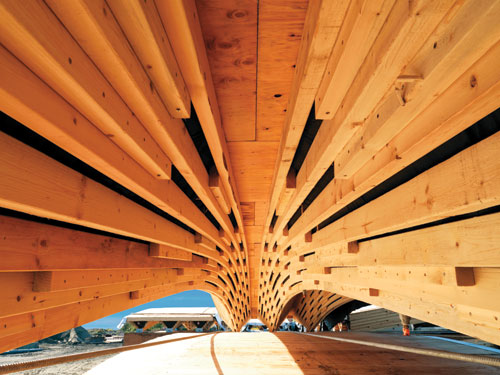 |
Wood wave panels were designed to create a one-of-a-kind roof from pine beetle wood at Richmond Olympic Oval, Vancouver, British Columbia, Canada. Architect: Cannon Design Photo courtesy of www.naturallywood.com |
At the 2005 World Summit, it was noted that sustainability requires the reconciliation of environmental, social and economic demands, the "three pillars" of sustainability. According to the U.S. Environmental Protection Agency, "Sustainability is based on a simple principle: Everything that we need for our survival and well-being depends, either directly or indirectly, on our natural environment. Sustainability creates and maintains the conditions under which humans and nature can exist in productive harmony, that permit fulfilling the social, economic and other requirements of present and future generations."1 According to the American Institute of Architects (AIA) Sustainability Discussion Group's definition of sustainability and carbon reduction, "Sustainability envisions the enduring prosperity of all living things. Sustainable design creates communities and buildings that advance enduring public and environmental well-being." While the Discussion Group endorses the broadest definition of sustainable design, it seeks action on a critical, focused, measurable and achievable priority: carbon neutral buildings and communities by 2030.2
Wood and the Environment
Life cycle assessment (LCA) is accepted worldwide as a means of evaluating and comparing the environmental impacts of building materials, products and complete structures—from resource extraction through manufacturing, transportation, installation, building operation, decommissioning and eventual disposal. Defined by the International Organization for Standardization, it allows building designers to compare different building designs based on their true environmental impacts and make informed choices about the materials they use.
LCA studies have consistently shown that wood is better for the environment than either steel or concrete in terms of embodied energy, air and water pollution, and carbon footprint.3 Research worldwide indicates that concrete construction is preferable to steel-frame construction in terms of energy use, but inferior to steel in generation of carbon dioxide (CO2) and other greenhouse gases. For example, a Swedish study of concrete and wood-framed buildings found higher energy and CO2 balances for the concrete structures.4 A New Zealand comparison of cradle-to-grave energy use and greenhouse gas emissions associated with four versions of an office building found that, as the amount of wood products increased versus concrete and steel, the amount of greenhouse gas emissions decreased.5 A U.S. Forest Service-sponsored life cycle assessment found that harvesting, transporting, manufacturing and using wood in lumber and panel products yields less greenhouse gases than other common building materials, such as concrete and steel. The study also found that wood-based wall systems can require significantly less total energy for manufacturing than thermally comparable steel or concrete structures.6
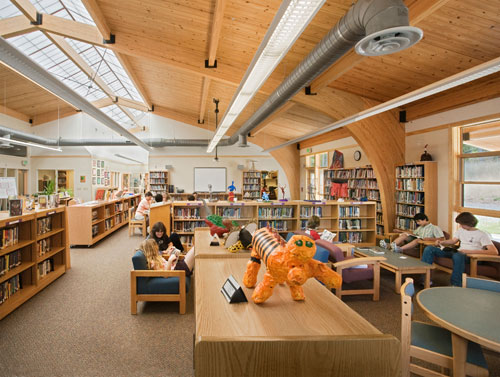 |
Duke School, Durham, North Carolina, Fielding Nair International with DTW Architects & Planners Photo by Jerry Markatos |
It may be that these studies will begin to inform public policy. Already, based on the third study above, the U.S. Forest Service announced that it will "preferentially select wood in new building construction and actively look for opportunities to demonstrate the innovative use of wood as a green building material for all new structures of 10,000 square feet or more using recognized green building standards such as LEED®, Green Globes™ or the National Green Building Standard.7" The U.S. Department of Agriculture, the parent agency, will commit to greater use of wood as it fulfills President Barack Obama's Executive Order on Federal Leadership in Environmental, Energy, and Economic Performance.8 USDA Secretary Tom Vilsack directed all other USDA divisions to incorporate the Forest Service policy of using domestic sustainable wood products as the preferred green building material for all USDA facilities and buildings.
Calculating the Impacts of Building Designs |
Numerous free tools are available to evaluate the environmental impacts of building designs. The ATHENA Impact Estimator for Buildings gives users access to life cycle data without requiring advanced skills. It can model over 1,200 structural and envelope assembly combinations, allowing for quick and easy comparison of design options.* The WoodWorks Carbon Calculator focuses on carbon footprint. Users input the volume of wood in a building, and the calculator estimates how much carbon is stored in the wood, the greenhouse gas emissions avoided by not using steel or concrete, and the amount of time it takes North American forests to grow that volume of wood.** |
Sources: |
In building materials there is always a choice—wood studs or steel studs, wood floors or concrete slab—that affects a structure's carbon footprint, says Bruce Lippke, University of Washington professor emeritus of forest resources and lead author of a paper that appeared in the June 2011 issue of Carbon Management. Using life cycle assessment, Lippke and his team estimated that replacing steel floor joists with engineered wood joists reduces the carbon footprint of the joists by almost 10 tons of carbon dioxide for every ton of wood used. Utilizing wood flooring instead of concrete slab flooring was found to reduce the carbon footprint by approximately 3.5 tons of carbon dioxide for every ton of wood used.
The paper also noted that, to maximize the carbon benefits, the best approach is to harvest before tree growth begins to taper off, and then use the wood in place of products that are most fossil fuel-intensive. However, this does not mean that all forests should be harvested this way. "While the carbon in the wood stored in forests is substantial, like any garden, forests have limited capacity to absorb carbon from the atmosphere as they age," writes Lippke. "And there's always a chance a fire will sweep through a mature forest, immediately releasing the carbon dioxide in the trees back to the atmosphere." Older forests provide immense value, though their ability to absorb carbon dioxide slows down.
Carbon Chart |
 |
A Northwest state or private forest, harvested regularly for 100 years, helps keep carbon dioxide out of the atmosphere year after year by storing carbon in long-term wood products (blue) and by substituting wood for fossil-fuel-intensive products like steel and cement, thus avoids carbon dioxide emissions during their manufacture (orange). The chart also shows carbon that remains in a sustainably managed and harvested forest (green and black); and an “emissions” line (cranberry) at the bottom, representing the energy to harvest and process wood, which is partly counterbalanced by the “mill residual” line (yellow) that represents mill wastes burned for energy in place of fossil fuels. |
Chart courtesy of E Oneil/U of Washington |
As the design community focuses on carbon-neutral building, the carbon benefits of individual structures are being evaluated and documented. Avalon Anaheim Stadium, a luxury apartment and retail complex in California, includes more than 2 million board feet (equivalent) of lumber and sheathing—which will continue to store nearly 4,000 metric tons of carbon for the lifetime of the building, or longer if the wood is reclaimed and used elsewhere. By using wood instead of steel or concrete, the design team also avoided an estimated 8,000 metric tons of greenhouse gas emissions, for a total potential carbon benefit of 12,000 metric tons. These savings are equivalent to the annual greenhouse gas emissions from 2,400 passenger vehicles or the operation of 1,054 homes.10
End of Life. According to the U.S. EPA, approximately 170 million tons of building-related construction and demolition (C&D) materials were generated in the U.S. in 2003, an increase of 25 percent since 1996. Of this, 39 percent came from residential sources, including new construction, renovation and demolition, and 61 percent came from non-residential sources. Although data on the recovery of materials is limited, the EPA estimates that 52 percent of building-related C&D materials were discarded in 2003—a statistic that highlights the need for ongoing attention to environmentally sound strategies for a material's end of life.11
 |
For Avalon Bay Communities, which developed the Avalon Anaheim Stadium project, podium structures represent approximately 25 percent of projects nationwide and 55 percent in Southern California. Photo courtesy of Withee Malcolm Architects © Arden Photography |
Recycling and reuse are encouraged for all building materials and sanctioned by various green building rating systems. But the first step in any recycling or reuse program is effective material recovery. Wood recovery is improving, with a rapid growth in the number of companies processing recovered wood and matching salvaged timber with designers' needs. According to a report by the U.S. Forest Products Laboratory, wood product manufacturers capture almost all of their wood waste. However, wood recovery from the municipal waste stream (MWS) and C&D sources are less effective. In 2010, 15.9 million tons of wood waste were generated by the MWS and only 15 percent was recovered (not counting recovery for energy combustion).12
Construction wood waste has good potential for recovery improvement because it is generally clean and easy to separate. While 27 percent is already recovered, burned or not usable, some 73 percent of this wood is available for salvage. Demolition waste is more difficult as it is highly mixed and possibly contaminated with other materials. Only an estimated 41 percent of demolition wood waste is available for recapture with standard demolition processes, which do not lend themselves to cost-effective retrieval. One solution is deconstruction, which selectively dismantles a building in order to carefully remove re-usable or recyclable parts. Wood can be reclaimed from de-commissioned buildings and directly reused, a niche market that is increasing due to strong interest in salvaged large-dimension timbers. Also, there is a large and relatively untapped store of lumber in the aging North American housing stock. Many jurisdictions have already begun to determine options to reduce waste, and are viewing wood waste reduction programs as critical to their overall waste management solution.
Wood and Social Goals
Wood is a material that exudes warmth and natural beauty, and can have a beneficial affect on building users. Biophilia, a term created by German psychologist Erich Fromm, relates to the instinctive bond that exists between humans and other living systems and helps explain how wood contributes to a socially positive experience. People respond emotionally to wood; they are attracted to its visual variety and natural expressiveness.
A recent study at the University of British Columbia and FPInnovations found that the visual presence of wood in a room lowers sympathetic nervous system (SNS) activation in occupants, further establishing the positive link between wood and human health.13 Through SNS activation, human bodies prepare themselves to deal with stress, increasing blood pressure and heart rate while inhibiting digestion, recovery and repair functions to deal with immediate threats. While necessary in the short term, prolonged SNS activation negatively impacts the body. The study supports wood's value in evidence-based design, a field that promotes health, increased productivity and well-being based on scientifically credible evidence, and is being increasingly adopted by the healthcare industry.
Healthcare architects have been at the forefront of this effort, exploring the physiological benefits of good design on patient recovery and the well-being of staff and visitors. Among the results, an increasing number of healthcare facilities are making use of natural daylight, views of nature, and exposed wood to create a warm, natural aesthetic that supports their healing objectives.14
 |
Wood is often used in healthcare centers because of its connection to nature. Photo courtesy of TWP Architecture © Curtis Waltz |
At the Herrington Recovery Center for alcohol and chemical dependency, architects complemented the lakeside setting with natural cedar and stained wood both inside and out. Wood ceilings and soffits in the recreation room and entrances to sleeping rooms brought warmth to the space, helping patients feel more comfortable. Exposed glued laminated timber (glulam) beams allowed for soaring ceilings and clerestory windows provided natural light. Wood floor systems created a forgiving surface underneath. "It's amazing how well this project has been received—by patients, by the surrounding community and by the healthcare and design communities," says architect John Curran, ALA, Senior Vice President for TWP Architecture, noting that wood helped create an environment in which patients felt more at home.
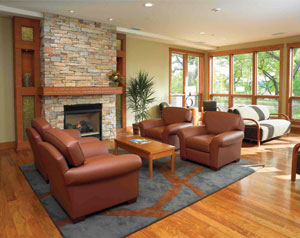 |
The design and construction team used natural cedar and stained wood to create warmth both inside and out. Photo courtesy of TWP Architecture. © Tom Davenport |
Wood's ability to create warmth and provide an enriching environment is also cited as a reason for its use in many schools. In a three-year study of 700 schools, Japanese researchers examined how the educational environment is influenced by a school's building materials. Data found reduced flu outbreaks in wood-framed schools compared to concrete facilities. Another Japanese study measured the impression of teachers and students concerning wood versus reinforced concrete. Both groups reported favorable impressions of wood schools, with teachers and students in wood schools feeling less fatigue.15
Another study, this time in Austria, found that interior wood use in classrooms reduced pupils’ stress levels, as indicated by criteria that included heart rate and perceived stress from interaction with teachers.16
Wood and Economic Considerations
Wood products offer advantages in terms of cost. As a material grown throughout North America, they can be locally sourced and are usually less expensive than alternative building materials. Wood building systems typically cost less to install than other materials. Whether comprised of traditional wood framing, panelized products or prefabricated assemblies, wood construction is fast, expediting project completion. Wood's relative light weight reduces the need for foundation capacity and associated costs. Further, most communities have a large pool of qualified tradespeople with wood framing experience, which minimizes construction delays and keeps labor costs competitive.
Anecdotal evidence points to wood's cost advantage in many applications. Speed and ease of construction are generally considered to be key benefits of wood-frame buildings, attributes that help meet occupancy deadlines and directly impact budgets. For example, by using wood for the 320,000-square-foot El Dorado High School in Arkansas, the project team saved an estimated $2.7 million as compared to a similar masonry and steel building. "Integrating wood throughout the school proved to be an economical option," says project architect Blake Dunn of CADM Architecture. Similarly, the Fountain Lake School District of Hot Springs, Arkansas, saved $2.7 million on a 63,000-square-foot project that included a new middle school and high school renovation by switching to wood from the original masonry and steel design. "Wood works particularly well when a project has a tight construction schedule," says Mark Batten, SE, with Burkett & Wong Engineers in San Diego. "Contractors can get started right away without waiting for steel shop drawings or steel fabrication. When we design a wood-framed school, we do so primarily because of cost, schedule, and ease of construction."
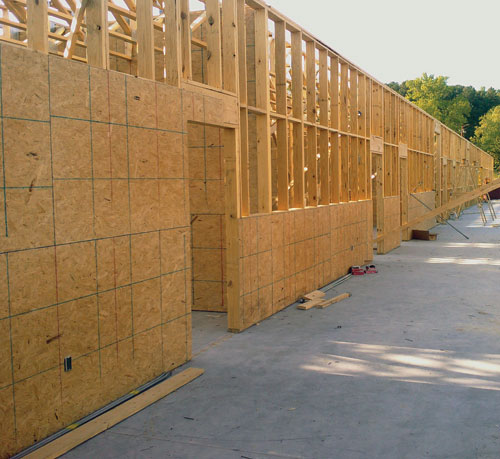 |
Fountain Lake School saved time and money by specifying wood as a structural building material. |
Wood's cost effectiveness isn't limited to schools. TWP Architecture's Curran, says of the Herrington Recovery Center, "Certainly from a cost standpoint, it made a lot of sense to do the whole thing on a wood frame." In Seattle, architects used a wood-frame podium to financial advantage in the Marselle Condominiums, a 160,000-square-foot structure that includes five and one-half stories of wood over a two-story concrete podium deck. Though the condos achieved local environmental certification, the decision to use wood framing was purely financial, according to Kory Knudson, Vice President of Norcon, NW, Inc. "If the project had been built using all concrete, for instance, it would have cost about 30 percent more. If we had built the entire project out of steel, it would have taken much longer and we would have had to make many energy modifications."
Encouraging the use of wood from responsibly managed forests offers considerable economic benefits. The American Forest & Paper Association says the U.S. forest products industry as a whole employs nearly 900,000 people, making the industry a top 10 manufacturing employer in 47 states, and the wood manufacturing segment accounts for more than a third of those jobs.
The World Bank, which estimates that more than 1.6 billion people worldwide depend on forests for their livelihoods, maintains that the forest industry is a source of economic growth and employment, with more than $186 billion worth of global forest products traded internationally.17 According to the United Nations, at least 10 million jobs could be created in sustainable forest management, with Asia, Africa and Latin America benefitting the most. Depending on the local circumstances of a country and resources available, jobs could be provided in forest management, afforestation and reforestation, agro- and farm-forestry and improved fire management, as well as construction and management of recreation and tourism facilities. Most of these jobs would be in rural areas, where they would help improve living standards.18
Because restoring forests requires people, a number of countries, the U.S. and the Republic of Korea among them, have included forestry in their economic stimulus plans. A study conducted at the University of Massachusetts Political Economy and Research Institute found that, in the U.S., forestry is the most jobs-intense industry, outperforming even the second-most jobs-intense activity by 74 percent, and far exceeding other major job alternatives, including new highway construction, and financial services.19 "Our country has the resources, the work force, and the innovative spirit to reintroduce wood products into all aspects of the next generation of buildings," U.S. Forest Service Chief Tom Tidwell was quoted as saying. "We are getting smarter and more efficient in how we use wood products as both an energy and green building source."
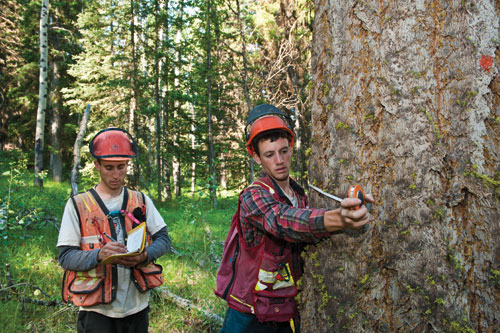 |
Long before a tree is cut, resource professionals identify the silvicultural system that best meets the unique needs of each site. A silvicultural system covers all activities from early planning through harvesting, replanting and tending the new trees. Photo courtesy of www.naturallywood.com |
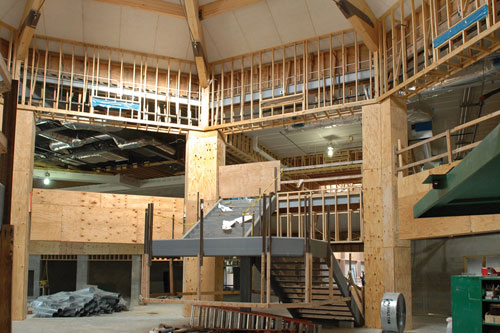 |
El Dorado High School, El Dorado, Arkansas. Photo courtesy of CADM Architecture © W.I. Bell, courtesy WoodWorks |
Codes and Green Rating Systems—Do They Mean A Sustainable Building?
"Green" building codes are the next step in improving the performance of buildings and reducing their environmental impacts. The California Green Building Standards Code (CALGreen),20 was the first U.S. code to incorporate LCA (which it includes as a voluntary provision). The American Society of Heating, Refrigerating and Air-Conditioning Engineers (ASHRAE) Standard 189.1 sets minimum green building requirements and is the nation's first code-intended standard for high-performance buildings. The International Green Construction Code (IgCC) was released in 2012 and is being adopted on a voluntary basis by a growing number of jurisdictions. "Public awareness of sustainable building is a major driver of codifying green building," says Lisa Podesto, MS, PE, WoodWorks' Senior Technical Director, Architectural and Engineering Solutions. "LEED® and other rating systems have done the lion's share of bringing green building into the everyday vocabulary, but these systems are voluntary and the codes are now required to set a baseline. As a society, the motivation to codify green building comes from wanting to keep pace with other industrialized nations, the need to reduce the environmental drains on our society and, in the end, save money."
As codes foster more sustainable buildings in general, there is increasing recognition of wood as a desirable building material. In the southern part of the U.S., for example, there has been a movement to revise or repeal policies that have prohibited the use of wood in school construction. In 2009 when Arkansas changed its rules in this area, El Dorado High School was one of the first to take advantage of this change. The school features glulam bowstring roof trusses that span 160 feet over the basketball arena, while exposed gabled laminated rafters span 23 feet in the main street corridors. Where the corridors meet, an octagonal rotunda features large architectural grade glulam beams at each hip topped with a clear glass skylight. Dimension lumber is used in exterior and interior load bearing walls, while I-joists are used to support the roof and concrete slab second floor. CADM's Dunn says, "The use of exposed wood products in structural systems and elements such as doors, millwork and trim also provides a unique architectural aesthetic that helps to naturally soften and warm the spaces where they occur." By using wood, the building achieved a total carbon benefit of 5,150 metric tons. This includes 3,660 metric tons of carbon stored in the wood and an estimated 7,780 metric tons of emissions avoided by not using concrete or steel. This is equivalent to the annual greenhouse gas emissions from 2,100 cars or from the energy to operate one home for 970 years. This is equivalent to the annual greenhouse gas emissions from 985 cars or from the energy to operate one home for 435 years.21
Arkansas' move to allow wood in school construction has led to similar policy changes in North Carolina and South Carolina.
As architects grapple with how to design for sustainability, voluntary building rating systems have become popular tools to confirm green credentials for commercial buildings. The most commonly used green design rating systems are:
BREEAM. The UK-based Building Research Establishment's (BRE) Environmental Assessment Method for offices, multi-family residential and ecoHomes offers credits in 10 categories according to performance, which are combined to produce a single score on a scale of Pass, Good, Very Good, Excellent and Outstanding. Established in 1990, BREEAM is the basis for most other rating systems and, with more than 100,000 certified buildings, is the world's most widely used green building rating system.22
Built Green. A voluntary program for residential construction, Built Green was started in the U.S. by home builders, and is available in several states, including Washington, Colorado and California. This is a voluntary self certification building process designed to create market distinction for builders, architects and property owners who incorporate green building practices in their projects.23
CASBEE® (The Comprehensive Assessment System for Building). Japan's green standard uses building environmental efficiency (BEE) as a basis for assessment by dividing the building environmental quality and performance by the building environmental loads. Developed by a committee under the initiative of the Ministry of Land, Infrastructure and Transport in 2001, the system has sequentially developed various categories including new construction, existing buildings and renovations.24
Green Globes™. A web-based environmental assessment and certification system that bills itself as offering an effective, practical and affordable way to assess and improve the sustainability of new and existing buildings. In the U.S., it is offered exclusively by the Green Building Initiative (GBI), which initiated the first ANSI standard for commercial green building, based on Green Globes. In Canada, the federal government uses the Green Globes suite of tools and it is the basis for the Building Owners and Managers Association of Canada's (BOMA) "Go Green Plus" program. 25
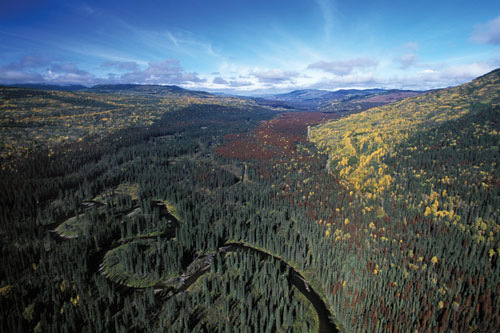 |
At present, only 10% of the world's forests are certified. Canada and the United States have the most certified forests with 365 million acres and 121 million acres respectively. Photo courtesy of www.naturallywood.com |
Green Star. Australia's green standard launched by the Green Building Council of Australia in 2003. Since then, a variety of Green Star rating tools have been developed from multi-unit residential to retail, office and office interiors. There are currently similar programs in New Zealand and South Africa.26
LEED®. The Leadership in Energy and Environmental Design system was developed by the U.S. Green Building Council and provides third-party verification that a building or community was designed and built using strategies that improve performance in the following areas: Energy Savings, Water Efficiency, CO2 Emissions Reduction, Stewardship of Resources and Sensitivity to their Impacts, and Indoor Environmental Quality. LEED rating systems are tailored to various market segments. LEED version 4 was approved in 2013. LEED is also used in countries such as Canada, China, India, Mexico, etc.27
Living Building Challenge (LBC). This program of the Cascadia Green Building Council is mainly active in the U.S. and Canada and is meant to be the next step after LEED Platinum and a step before regenerative buildings. It is intended "to define the highest measure of sustainability attainable in the built environment based on the best current thinking—recognizing that 'true sustainability' is not yet possible." As of August 2013, six building projects have achieved LBC certification.28
NAHB Model Green Home Building Guidelines. These guidelines, now part of NAHB's National Green Building Program, were published in 2005. They are the basis for the Green Scoring Tool, and can also function as the foundation for local organizations' green building programs.29
Sustainable Forest Management— |
Wood products that come from sustainably managed forests are a good choice for sustainable building. Responsible forest management in North America has resulted in more than 50 consecutive years of net forest growth that exceeds the amount of timber harvested. Canada and the United States regulate harvest levels with an upper limit to maintain forest resources. In Canada, where 93 percent of the forest land is publicly owned, government authorities set prescriptive harvesting levels following a detailed analysis of timber supply. In the U.S., which has a large number of smaller-scale private land owners, harvest levels are based on maturity criteria at the forest stand level. North America has more certified forests than any other part of the world and all major forest certification programs in North America are recognized globally. Forests offer many different values, which responsible forest practices seek to maintain and protect, including wildlife habitat, biodiversity, recreation and products that range from lumber and paper, to medical supplies, fuel and clothing. |
The SB Tool. This software implementation of the Green Building Challenge assessment method has been under development since 1996. Initially launched by Natural Resources Canada, the process is now the responsibility of the International Initiative for a Sustainable Built Environment.30
A 2010 study by Light House Sustainable Building Centre found that, while the intensity of wood used in a project did not have a large impact on the number of total potential credits, it was clear that certain rating systems are more "wood-friendly" than others.31 Rating systems for single-family homes, such as BuiltGreen, were most predisposed towards wood, while commercial building systems such as LEED (U.S. and Canada) made it slightly easier to score points by not using wood. "Rating systems have become the definition of energy-efficient and environmentally responsible building, but that represents a limited view," says Helen Goodland, previously with Light House and now a principal with Brantwood Consulting, a green building technical advisory firm. "Wood can help designers create greener buildings, yet we found that wood's most significant ecological benefits—that it is the only carbon-neutral construction material and that it can significantly reduce a building's life cycle impacts—are largely unrecognized by the most commonly used rating systems." Goodland notes that most rating systems have gaps in areas where wood may play a positive role, including acoustical performance, life cycle assessment and material efficiency.
An alternative approach is Passive House, which focuses solely on reducing energy consumption, without other requirements. Aiming to cut heating energy consumption of buildings by 90 percent, Passive House emphasizes superinsulation and air-tight construction primarily heated by passive solar gain and by internal gains from people, electrical equipment, etc. without applying expensive active technologies like photovoltaics or solar thermal hot water systems. Over the last 10 years more than 15,000 buildings in Europe—including homes as well as schools, factories and office buildings—have met the Passive House standard.
Green Hammer Design & Build in Portland, Oregon, was among the first to design a U.S. office space to Passive House standards. The 2,600-square-foot wood frame structure with a truss roof system is an office for Oregon's Farmworker Union. "We used wood because of its relatively low carbon footprint, its low embodied energy, our ability to source reclaimed wood, and wood's cost effectiveness," says Stephen Aiguier, Green Hammer's Founder and President. "Because it is a smaller building, wood was far more economical than masonry construction."
As demand for sustainable building continues to increase, the design community will need to understand what is meant by true sustainability. Current practices and materials may need to be reconsidered in light of that definition. Still, there are a range of options for sustainable design, and innovative architects are finding improved environmental performance via many avenues. One way is certainly by using wood. A carbon-neutral, energy-efficient material that can achieve the three goals of true sustainability—environmental, social and economic—wood is also a truly renewable building material in the architect's toolbox.
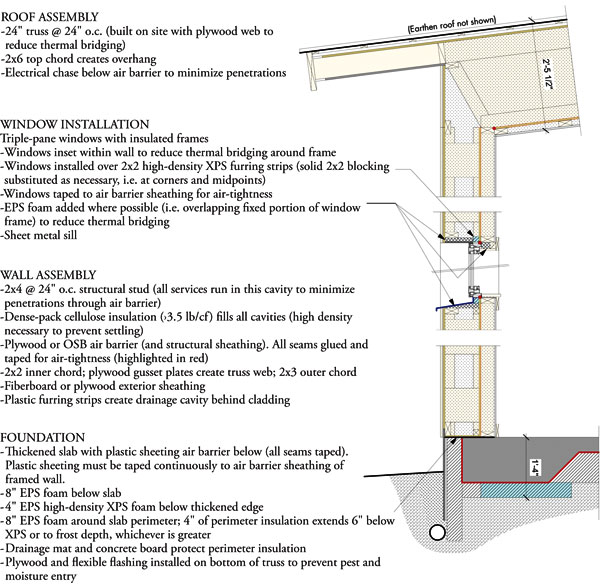 |
Details of Oregon's Farmworker Union building, designed by using Passive House standards. Image courtesy of Green Hammer Design & Build |
| ENDNOTES |
|
1. http://www.epa.gov/sustainability/basicinfo.htm#sustainability 2. http://info.aia.org/toolkit2030/advocacy/aia.html 3. Werner, F. and Richter, K. 2007. Wooden building products in comparative LCA: A literature review. International Journal of Life Cycle Assessment, 4. Gustavsson and Sathre 2006; Gustavsson et al. 2006 5. Nebel, Perez, Buchanan, 2009 6. http://www.corrim.org/pubs/articles/2004/FPJ_Sept2004.pdf 8. http://www.whitehouse.gov/administration/eop/ceq/sustainability 9. Carbon Management, June 2011, Vol. 2, No. 3, pages 303-333, Life Cycle Impacts of Forest Management and Wood Utilization on Carbon Mitigation: Knowns and Unknowns, Bruce Lippke, Elaine O'neil, Rob Harrison, Kenneth Skog, Leif Gustavsson, Roger Sathre 10. http://woodworks.org/files/PDF/publications/Carbon-Footprint.pdf 11. Estimating 2003 Building-Related Construction and Demolition Materials Amounts, U.S. Environmental Protection Agency, 12. Sector Analysis: Generation and Recovery of Solid Wood Waste in the U.S., Biocycle, August 2012, USDA Forest Products Laboratory, 13. Wood in the Human Environment : Restorative Properties of Wood in the Built Indoor Environment http://hdl.handle.net/2429/28644 14. The Human Response to Wood, http://continuingeducation.construction.com/article.php?L=312&C=1104 15. Approaching the Design and Planning for School Capital Program with Wood, Mikio Moronuki, Research Centre for Educational Facilities, Tomoe Corporation; Building Schools with a Wooden Design, Ben Nakmura, Institute of Technologies 16. C. Kelz1,2, Grote V.1,2, Moser M.1,2, Interior wood use in classrooms reduces pupils’ stress levels, 1Institute of Physiology, Medical University of Graz, Austria; 2HUMAN RESEARCH, Institute for Health, Technology and Prevention Research, Weiz, Austria 17. World Bank Forests & Forestry, http://web.worldbank.org/WBSITE/EXTERNAL/TOPICS/EXTARD/EXTFORESTS/ 18. State of the World's Forest Report 2009, United Nations Food and Agriculture Organization, http://www.fao.org/docrep/011/i0350e/i0350e00.htm 19. http://www.peri.umass.edu/236/hash/efc9f7456a/publication/333/ 20. http://www.bsc.ca.gov/home/calgreen.aspx 21. Estimated using the WoodWorks Carbon Calculator, www.woodworks.org 23. http://www.builtgreen.net/ 24. http://www.ibec.or.jp/CASBEE/english/overviewE.htm 26. http://www.gbca.org.au/green-star/green-star-overview/ 27. http://www.usgbc.org/DisplayPage.aspx?CategoryID=19 28. http://living-future.org/lbc 30. http://www.iisbe.org/taxonomy/term/105 31. http://www.naturallywood.com/sites/default/files/Green-Rating-System.PDF |
 |
The reThink Wood initiative is a coalition of interests representing North America's wood products industry and related stakeholders. The coalition shares a passion for wood and the forests it comes from. Innovative new technologies and building systems have enabled longer wood spans, taller walls, and higher buildings, and continue to expand the possibilities for wood use in construction. www.rethinkwood.com |
